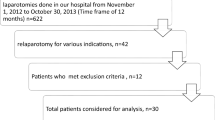Abstract
Background:
Relaparotomy is sometimes required for complications that develop after abdominal surgery, but it is associated with high mortality. We aimed to investigate the independent risk factors related to mortality in patients that undergo relaparotomies.
Materials and Methods:
One hundred and fourteen patients who had relaparatomies were evaluated. Risk factors studied were patient characteristics, cause of the first operation, condition of the first operation, systemic diseases, presence of peritonitis, relaparotomy interval, cause of relaparatomy, APACHE II score, transfused blood units, number of relaparatomies, length of hospital stay, and mortality. In order to determine the independent risk factors, we carried out multivariate logistic regression analysis.
Results:
There were 75 male and 39 female patients with a mean age of 46.06 ± 19.98 (15–84). The most common reasons for relaparotomy were leakage from intestinal primary repair or anastomosis (29.8%). Mortality developed in 55 (48.2%) patients undergoing relaparatomy. Intestinal necrosis (p = 0038) and intraabdominal sepsis (p = 0.027) were found to be risk factors in mortality. In multivariate logistic regression analysis, advanced age (OR 0.966, p = 0. 0.017) and APACHE II score ≥ 20 (OR 0.137, p < 0.0001) were found to be independent risk factors affecting mortality.
Conclusion:
Advanced age and APACHE II score ≥ 20 were found to be independent risk factors affecting relaparotomy-related mortality.
Similar content being viewed by others
References
Parker MC, Ellis M, Moran BJ, Thompson JN, Wilson MS, Menzies D. Postoperative adhesions: ten-year follow-up of 12584 patient undergoing lower abdominal surgery. Dis Colon Rectum 2001;44:822–830.
Unalp HR, Kamer E, Kar H, Bal A, Peskersoy M, Onal MA. Urgent abdominal re-explorations. World J Emerg Surg 2006;1:10.
Hutchins RR, Gunning P, Lucas DN, Allen-Mersh TG, Soni NC. Relaparotomy for suspected intraperitoneal sepsis after abdominal surgery. World J Surg 2004;28:137–141.
Schein M. Planned reoperations and open management in critical intra-abdominal infections: prospective experience in 52 cases. World J Surg 1991;15:537–545.
Bunt TJ. Urgent relaparotomy: the high-risk, no-choice operation. Surgery 1985;98:555–560.
Kirk RM. Reoperative surgery for early complication for abdominal and abdominothoracic operations. J R Soc Med 1988;81:7–9.
Zer M, Dux S, Dintsman M. The timing of relaparotomy and its influence on prognosis. A 10 year survey. Am J Surg 1980;139:338–343.
Knaus WA, Draper EA, Wagner DP, Zimmerman JE: APACHE II a severity of disease classification system. Crit Care Med 1985;13:818–829.
Wain MO, Sykes PA. Emergency abdominal re-exploration in a district general hospital. Ann R Coll Surg Engl 1987;69:169–174.
Hinsdale JG, Jaffe BM. Reoperations for intraabdominal sepsis. Ann Surg 1984;199:31–36.
Thompson JS, Baxter BT, Allison JG, Johnson FE, Lee KK, Park WY. Temporal patterns of postoperative complications. Arch Surg 2003;138:596–603.
Kriger AG, Shurkalin BK, Glushkov PS, Andreitsev IL. Diagnosis and treatment of postoperative intraabdominal complications. Khirurgiia 2003;8:19–23.
Zavernyi LG, Poida AI, Melik VM, Bondarenko ND, Tarasov AA, Nadeev SS, Stepanik IVa. Prognosis in the outcome of relaparotomy. Klin Khir 1992;8:12–16.
Rygachev GP, Nekhaev AN, Kerez PI, Kremen VE: Relaparotomy in the treatment of generalized postoperative peritonitis. Khirurgiia 1997;1:45–48.
Harbrecht PJ, Garrison RNl, Fry DE. Early urgent relaparotomy. Arch Surg 1984;119:369–374.
Mucha PJR. Small intestinal obstruction. Surg Clin North Am 1987;67:597–620.
Fevang BT, Fevang JM, Stangeland L, Soreide O, Svanes K, Viste A. Complications and death after surgical treatment of small bowel obstruction: a 35-year institutional experience. Ann Surg 2000;231:529–537.
Uludağ M, Akgün İ, Yetkin G, Kebudi A, _Isgör A, Sener A. Factors affecting morbidit and mortality in mechanical intestinal obstruction. Ulus Travma Acil Cerrahi Derg 2004;10:177–184.
Derici H, Unalp HR, Bozdag AD, Nazli O, Tansug T, Kamer E. Factors affecting morbidity and mortality in incarcerated abdominal wall hernias. Hernia 2007;11:341–346.
Berger D, Buttenschoen K. Management of abdominal sepsis. Langenbecks Arch Surg 1998;383:35–43.
Mulier S, Penninckx F, Verwaest C, Filez L, Aerts R, Fieuws S, Lauwers P. Factors affecting mortality in generalized postoperative peritonitis: multivariate analysis in 96 patients. World J Surg 2003;27:379–384.
Malangoni M. Contributions to the management of intraabdominal infections. Am J Surg 2005;190:255–259.
Ordonez CA, Puyana JC. Management of peritonitis in the critically ill patient. Surg Clin N Am 2006;86:1323–1349.
Baue AE. Multiple organ dysfunction syndrome. Arch Surg 1997;132:703–707.
McCrory C, Crowley K. Is repeat laparotomy of value in patients with suspected intraabdominal sepsis in the intensive care unit? Ir J Med Sci 1997;166:88–91.
Koperna T, Semmler D, Marian F. Risk stratification in emergency surgical patients. Arch Surg 2001;136:55–59.
Barie PS, Hydo LJ, Fiscer E. Development of multiple organ dysfunction syndrome in critically ill patients with perforated viscus: predictive value of APACHE severity scoring. Arch Surg 1996;131:37–43.
Ohmann C, Hau T. Prognostic indices in peritonitis. Hepatogastroenterology 1997;44:937–946.
Giebel GD, Troidl H. Möglichkeiten und grenzen von scores: theoretische überlegungen über scores. Langenbecks Arch Surg 1996;381:59–62.
Berger MM, Marazzi A, Freeman J, Chiolero R. Evaluation of the consistency of acute physiology and chronic healthy evaluation (APACHE II) scoring in the surgical intensive care unit. Crit Care Med 1992;20:1681–1687.
Giangiuliani G, Mancini A, Gui D. Validation of a severity of illness score (APACHE II) in a surgical intensive care unit. Intensive Care Med 1989;15:519–522.
Oskvig RM. Special problems in elderly. Chest 1999;115:158–164.
Rosenthal RA, Zenilman ME. Surgery in elderly. In: Towsend CM, Beauchamp RD, Evers MB, Mattox KL, eds. The biological basis of modern surgical practice, 16th ed. Philadelphia: WB Saunders, 2001:226–246.
Mclnytre R, Reinbach D, Cushuieri RJ. Emergency abdominal surgery in the elderly. JR Coll Surg Edinb 1997;42:1738.
Karanikas ID, Liakakos TD, Koundourakis SS, Tzorakis SE, Dendrinos SS. Emergency operations in elderly: management of outcome. Int Surg 1996;81:158–162.
Rosenthal RA, Andersen DK. Physiologic considerations in the elderly surgical patient. In: Miller TA, ed. Modern surgical care, 2nd ed. St Louis: Quality Medical Publishing Inc.; 1998;1362–1384.
Author information
Authors and Affiliations
Corresponding author
Rights and permissions
About this article
Cite this article
Gedik, E., Söylemez, K., Girgin, S. et al. Relaparotomies: Why is Mortality Higher?. Eur J Trauma 35, 547–552 (2009). https://doi.org/10.1007/s00068-009-8221-2
Received:
Accepted:
Published:
Issue Date:
DOI: https://doi.org/10.1007/s00068-009-8221-2




